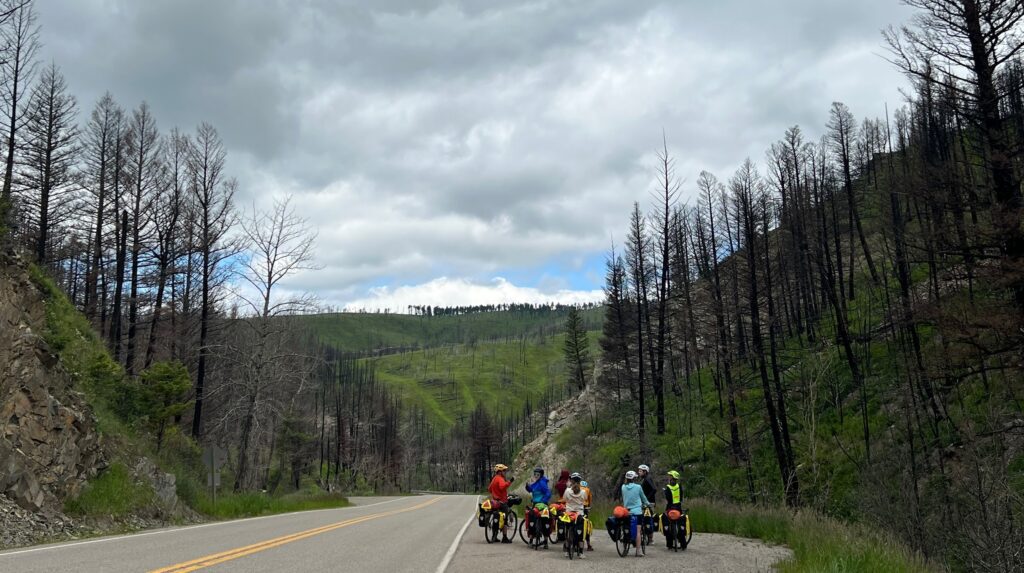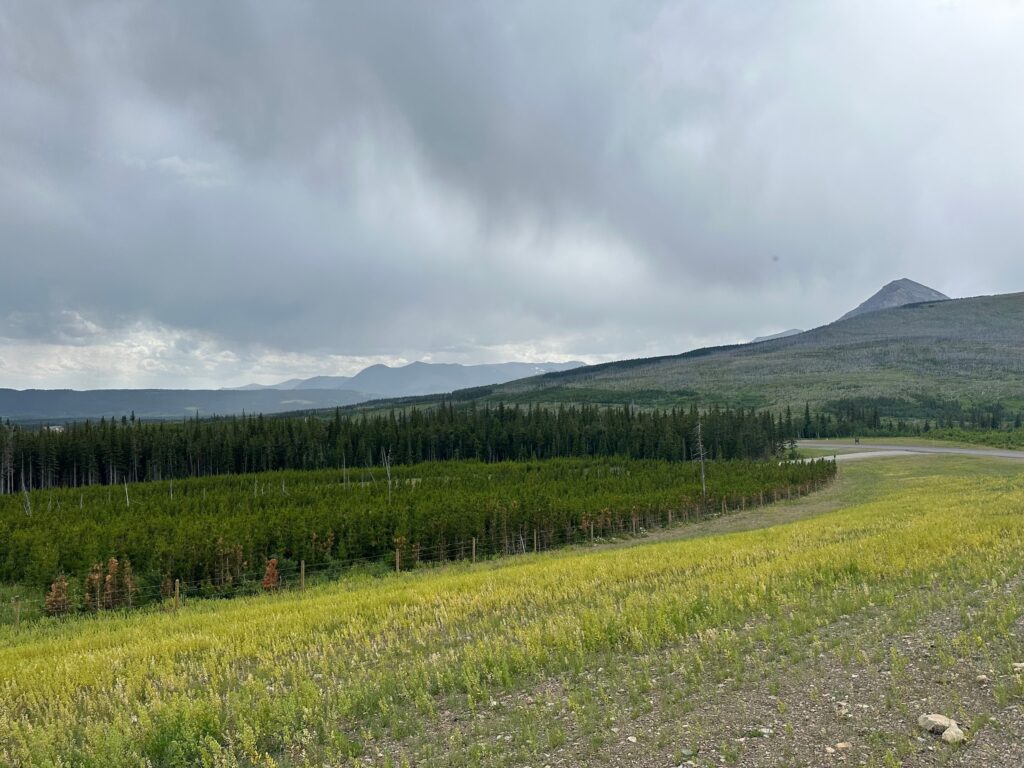
Excited anticipation built as I crept to the top of the final grassy hill before Deep Creek Canyon Pass. Up, over, and suddenly on the descent, a gust of wind hit me as I soared into the canyon. My anticipation blew into a joyful, adrenaline filled rush narrated by the hum of my bike tires as they pushed 15, 20, 25 miles an hour. The forest covered walls of the mountain canyon engulfed me, and I felt like a train car dropping into a tunnel; a dense verdant green piled above with only the pine trunks nearest the road uncovered to remind me of the sturdy wood supporting this mountainside carpet. The road wiped me left then right then — woosh — the pine canopy tunnel disappeared, receding into a lively light green sparkle cast onto the mountain walls disrupted by charred rods that poked out of the landscape. Like a breath of fresh air, the luscious low vegetation shone bright, yet the blackened trunks held a firm reminder of the old forest that was lost. As quickly as I emerged, the dense pine canopy tunneled me once again and I coasted along the mountain creek and out of the Helena National Forest.
In 2021 this area was hit with a wildfire that was suppressed before it could spread through the whole forest. A 4,600-acre mark remains as a reminder. The vibrant mountainside cut out of the deep timber was not what I had expected the forest to look like 2 years after it had been charred to soil. The lush undergrowth seemed out of place and contrasted starkly against the dead pine’s bare trunks. Was I seeing beauty or horror? Revival or death? That image didn’t match with what I knew about wildfires: after all, why would Smokey work so hard to protect his forests if they looked so lively after a burn?

I sat with a smokey perception of wildfires for a week until we pedaled into the town of Augusta. In pure WRFI fashion, we made an unplanned schedule adjustment to capitalize on an opportunity to meet with Anthony Emacio, the assistant fire manager of the Helena Lewis and Clark Forestry district. With Deep Canyon Creek on my mind, I was eager to clear up my perception of fire on wild landscapes.
“Some fire good, some fire bad.” Those words got me fired up. How could that be? Isn’t Smokey and the Forest Service waging war on fires? Turns out, they’re not, at least not anymore. In 1910, after what is known as “The Big Burn” where 3 million acres burned over 3 days and 85 lives were lost, the Forest Service shifted its focus from forest management to a new goal: total fire suppression. “10 AM fire suppression protocol: if a fire started, you could count on it being contained and suppressed by 10 AM the next day,” Anthony told us.
This practice was ecologically problematic and helped spur the massive wildfires we see today, along with decreased winter snowpack and extended fire seasons attributable to climate change. “Imagine a 5-gallon bucket of food in this room” Anthony said to all ten of us in his office. “How long is that going to support all of us? How long could that support just me?” That’s how the 10 AM fire protocol impacted our forests. “Fires have been naturally occurring and performed by indigenous peoples for thousands of years — nature relies on it.” Anthony’s job now embraces fire as a tool, either by prescribing it or allowing wildfire to take its natural course under controlled situations that minimize “bad” fire that encroaches on people and communities.

However, it’s becoming harder and harder for managers like Anthony to embrace fire’s natural role when some public perception remains rooted in a “bad fire” mentality. Without much understanding of fire’s traditional role in forestry, it’s emotional to see millions of acres burn yearly and encroach on your property, community, and aesthetic livelihood. What’s more, embers of fear from 1910 are stoked as fire intensity impacts far-flung places with smoke coverage reaching uncomfortably – and even dangerously – high levels. All of this intensifies public pressure to deploy suppressive fire tactics.
Less than 24 hours later we met with Hal Herring. His fiery personality and tell-it-like-it-is attitude cleared away the residual smoke surrounding my understanding of fire management. Hal is an award-willing conservation journalist who has spent most of his life either recreating outside or writing about it. “Conservation isn’t convenient. We’re naturally short-term thinkers.” Conservation isn’t an easy choice. It takes long-term thinking and systems analysis to look past our short sightedness. On one hand, the people of Blackfeet Nation, who have lived on the land for hundreds of years, have embedded forward-thinking and sustainable stewardship practices into their culture’s value of forests. On the other hand, western culture tends to value forests based on their use as resources or their scarcity. With those values, is there ever a convenient time to burn the forest? Hal’s metaphor for conservation was, “I like to smoke cigs, but I don’t because I want to go up hills.” We all like to have lush green forests, but the cost of that can involve upfront sacrifice and a little patience. It’s not a simple matter, or a convenient one. Honestly, I think Anthony was right: fires can be good and bad. But maybe before we make a decision, we should ask our forests. Because, after all, they’re the ones truly at the heart of the fire.